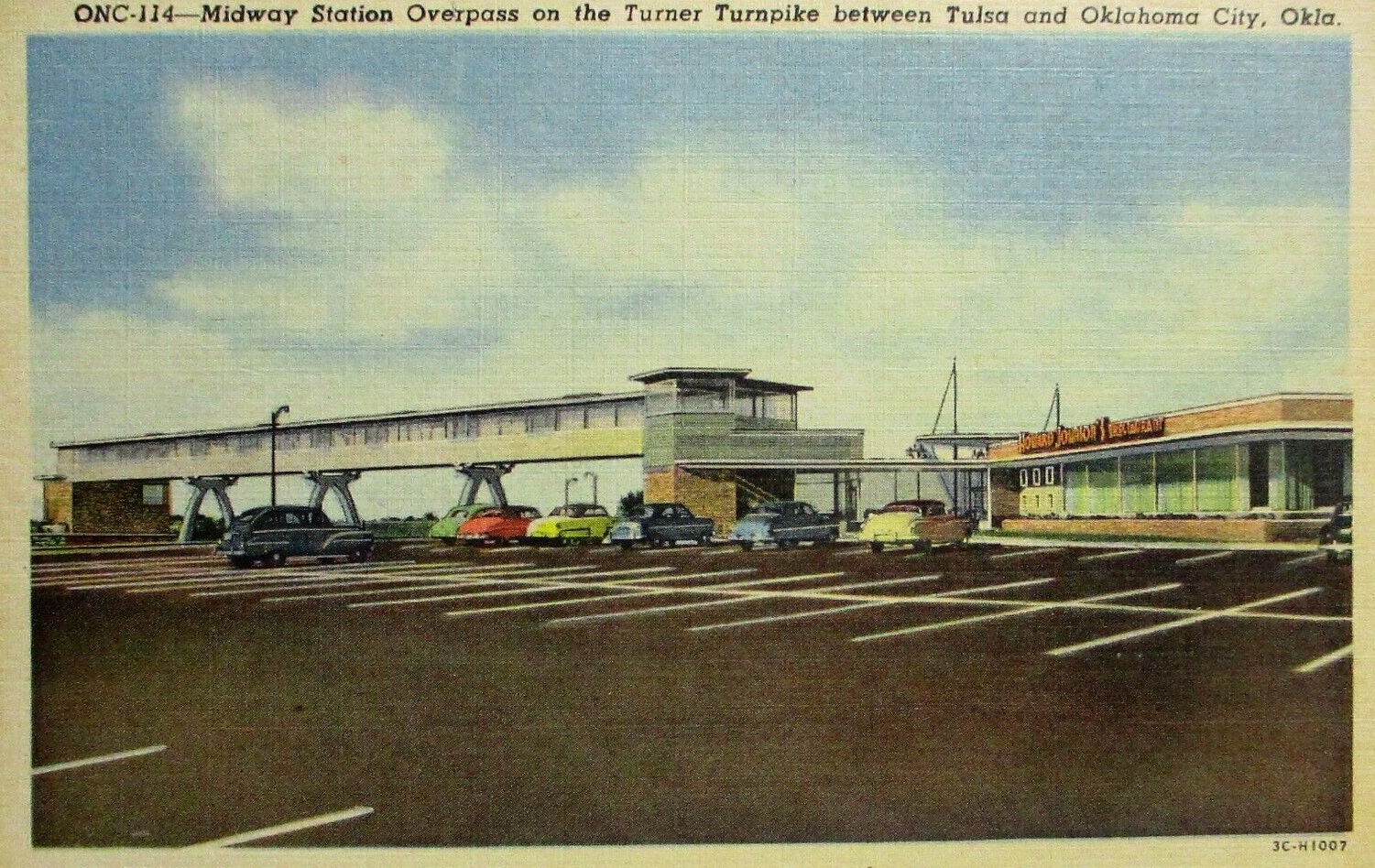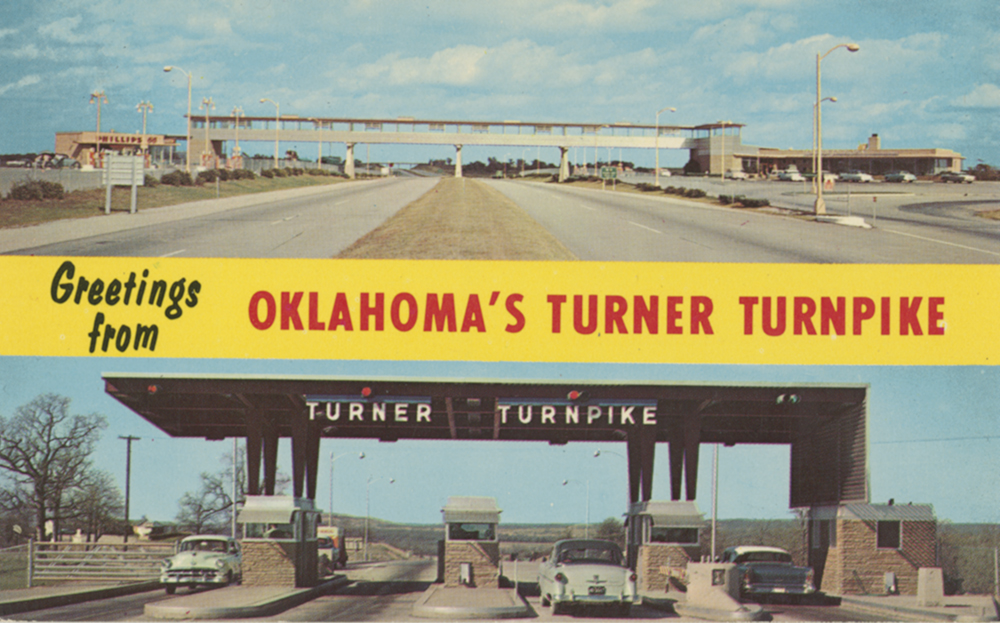Howard Johnson's on Oklahoma turnpikes

The last surviving Howard Johnson's restaurant, located in Lake George, New York, was recently found to have closed, evidently for good. An enthusiast, Alyssa Kelly, reported on Facebook over Memorial Day weekend that there were cobwebs on the door, a for-lease sign out front, and all the furnishings and memorabilia gone. This followed years of inconsistent schedules and poor management. One commenter on Kelly's post stated that the Lake George location didn't deserve the title of last HoJo's; but that honor belonged to the stores in Lake Placid, NY, Waterbury, CT, and Bangor, ME. Atlas Obscura profiled the Lake George HoJo's in 2019, noting that it had opened in 1953.
HoJo was once the largest restaurant chain in America, famous for fried clam rolls and 28 ice cream flavors (33 if you counted their five flavors of sherbet). The Bangor, Maine, HoJo's, which closed in 2016, was the last survivor in New England, where the chain got its start. This Yankee magazine feature story from 2015 outlines the history that began when Howard Johnson opened an ice cream parlor in the Wollaston neighborhood of Quincy, Mass., and describes the diner's mid-century atmosphere: "The deep red vinyl booths, wood paneling, patterned carpet, and the unmistakable whiff of restaurant/lounge mixed with fried food is a powerful combination."
Some HoJo fans mark as the beginning of the end the 2005 closure of the Times Square restaurant, with its spectacular neon depiction of the Simple Simon and the Pie Man logo.
The news got me thinking about the days when HoJo was dominant on Oklahoma's turnpikes. HighwayHost.org documents long-lost or much-changed chains that served the motoring public, thriving in the 1960s and 1970s, including Howard Johnson's, Horne's, Stuckey's, Holiday Inn, Alamo Plaza, Wigwam, Nickerson Farms. This page documents Howard Johnson's in Oklahoma, including motels in Tulsa, Oklahoma City, and Norman, standalone restaurants, and the many locations on Oklahoma turnpikes.
In 1953, Howard Johnson's won the restaurant concession for the newly opened Turner Turnpike, with the big restaurant on the eastbound side near Stroud (linked with the other direction of travel by a pedestrian overpass), counter-service cafes linked with Phillips 66 gas stations at Heyburn (first-stop westbound) and Chandler (first stop east-bound). Howard Johnson himself traveled to Oklahoma for the dedication. The Highway Host website says that HoJo also had a sit-down restaurant at Wellston and counter service at Bristow, but I never knew those sites as anything other than Stuckey's. The service areas were built by Phillips, who then sublet the restaurant spaces to HoJo.
The midway restaurant opened in early July 1953, and the other four were to be open by August 1, according to a July 5, 1953, Oklahoman story. The September 7, 1953, Oklahoman, reporting on plans to open freestanding stores in Oklahoma City and Tulsa, mentions that Phillips built the restaurant and service station buildings along the turnpike and sublet the restaurant spaces to Howard Johnson's. There was some controversy: Jack Abraham, owner of the J&J Restaurant in Bristow, wrote to the OTA to complain that the chain would hurt business for locally owned cafes (Oklahoman, April 5, 1953.) James Lileks has a postcard illustration of the Stroud Howard Johnson's mid-century modern interior.
Thinking back, it seems daft to place three separate service areas in each direction on an 86-mile turnpike. I suppose gas mileage was worse in 1953, although tanks were bigger. With a gas-guzzling V8, you might need 8 gallons -- half a tank -- to traverse the turnpike. I suppose that, at a time when regular highways had cafes and gas stations every few miles, putting them 20 miles apart seemed rather daring. On the slightly longer Will Rogers Turnpike, which opened in 1957, there were only two service areas in each direction -- westbound Miami, now a state welcome center, eastbound Claremore, and the Glass House over the turnpike in Vinita serving both directions. Conoco built the Miami and Vinita concessions, with Glass House running the restaurants; while Claremore was a Phillips/HoJo combination. Vinita was a Howard Johnson's, but on January 18, 1988, it became the World's Biggest McDonald's, at least until a rival opened in Moscow in 1990.
Around the same time, Howard Johnson's also built freestanding restaurants in Tulsa and Oklahoma City. Unlike the Phillips-built turnpike stores, these had the distinctive orange roofs and blue trim of the East Coast branches of the chain. In the 1970s, Howard Johnson's Motor Lodges appeared, including one on the I-44 service road east of 11th and Garnett, which was later a Travelodge, Econo Lodge, and Oaktree Inn.
A February 18, 1965, story in the Oklahoman reported that Phillips Petroleum Co., which had the concession contract from the Oklahoma Turnpike Authority, had received the OTA's approval to replace HoJo with Stuckey's at Bristow and Wellston. The story states that the restaurants at Heyburn, Chandler, and Stroud would continue to be Howard Johnson's but would be refurbished. "H. E. Bailey, consulting engineer, told the authority at its January meeting that Phillips was unhappy with the Johnson operation. He was critical of the Stroud restaurant and said local area residents have quit eating there."
As the H. E. Bailey, Indian Nations, and Muskogee Turnpikes were opened (1964, 1966, 1969, respectively), their service plazas were leased to Host International, which already operated the Glass House restaurants at Vinita and Miami. Unlike the older turnpikes, service areas on the new roads were placed between lanes of travel. On May 23, 1974, OTA decided to transfer all of Host International's concessions to Howard Johnson's, giving the chain a near monopoly (except for the two Stuckey's on the Turner).
In 1977, Howard Johnson's opened a national reservations call center in Oklahoma City.
A 1985 Oklahoma Turnpikes map -- a Gousha base map with details about turnpike service areas and tolls -- shows all the service areas as Howard Johnson's, including those on Indian Nations, H. E. Bailey, Cimarron, and Muskogee turnpikes, except for Wellston and Bristow, the former Stuckey's which were at that point run by McDonald's. That conversion happened in early 1984, and the April 8, 1984, Oklahoman reported that fences and rose bushes were planted to try to keep hungry drivers from crossing the turnpike to eat at Mickey D's. In reply, HoJo cut its coffee price from $1.10 to 75 cents.
In 1985, all gas concessions were Phillips 66, except for a Gibble Gas (!) at Lone Chimney on the Cimarron. The situation was already changing, as the August 22, 1985, Oklahoman reported that McDonald's now had contracts for seven of the 14 restaurant locations, apparently including the two former Stuckey's, the Chickasha service plaza on the H. E. Bailey turnpike, the Muskogee service plaza, and the two on the Indian Nations Turnpike, and the service area near Walters, at the south end of the H. E. Bailey, whose rebuilding was subsidized by OTA for $300,000. (Oklahoman, August 19, 1984.)
A September 23, 1986 story in the Oklahoman reports that the westbound Phillips 66 at Stroud and the pedestrian overpass were to be demolished and the westbound lanes to be rerouted to create a new service plaza (later to be named in honor of OTA engineer W. D. "Bill" Hoback). Only McDonald's bid for the new concession contract; Marriott, which owned Howard Johnson's at the time, and Hardee's were expected to bid, but passed up the opportunity.
The eastbound lanes stayed put and the old flagship HoJo remained derelict for a few more years -- this page has photos of the Stroud Howard Johnson's from its 1953 glory days and its abandoned state in 1992.
That same story mentions the demolition of the Heyburn and Chandler HoJo's, to be replaced with Phillips 66 convenience stores, of the type that were launched in the mid-80s, with a canopy covering a small central store building and pumps on either side. (Some examples could be found until recently at 31st and Yale and 15th and Utica in Tulsa.) The Heyburn store was closed and demolished in 2017. The Chandler store was demolished earlier this year. The Bristow and Wellston McDonald's buildings disappeared sometime between 2009 and 2011. Now new separate service plazas are being built -- one westbound near the current Hoback plaza, the other eastbound east of Chandler.
Midway was a regular stop for our family. Dad and Mom would usually indulge us, even though we were only an hour into a two-hour drive on our way to or from a visit to family in and around Midwest City, but it may have been that Dad wanted a smoke and Mom wanted a potty break. (It was a family tradition to point out a westbound auto safety billboard that said, "Drive slow so we all can go," which usually inspired Mom to look for the next available restroom.) Dad didn't like HoJo cola (none of us did), and we weren't going to stop for a sit-down meal in the middle of a short trip, so heading eastbound back to Tulsa we would "run over" the traffic to the westbound side, which had a Phillips 66 station and a Pepsi machine. While the restaurant held no interest for us, the gift shop at Midway was pretty interesting, with travel bingo cards and Indian-themes souvenirs. Even when we stopped at midway heading west, my sister and I would ask to go up the stairs to the walkway, just to sprint along the 100-foot enclosed bridge and look down on the traffic below. On one trip home, our 1969 Rambler stopped running at mile 22 eastbound, and we wound up crossing the turnpike to use the restrooms at the Wellston Stuckey's while waiting for a rescue -- a walkway would have been useful there.
Did Oklahomans ever really take to HoJo's in the 30 or so years they ruled the toll roads? When the turnpike concession was granted in 1953, Howard Johnson was an East Coast chain, and motorists from the South Central and Southwestern U. S. wouldn't have any associations with the brand, positive or negative. We didn't eat out often, and I don't ever remember stopping to eat at the Howard Johnson's on the turnpike or in town, nor do I remember friends or family talking about eating there. I vaguely recall stopping once at the Glass House over the Will Rogers Turnpike in the early 1970s.
MORE: Roadside Architecture website documents former Howard Johnson restaurants and motor lodges.
0 TrackBacks
Listed below are links to blogs that reference this entry: Howard Johnson's on Oklahoma turnpikes.
TrackBack URL for this entry: https://www.batesline.com/cgi-bin/mt/mt-tb.cgi/8934
 Postcard of the Turner Turnpike midway and toll gate.Courtesy of Metropolitan Library System of Oklahoma County
Postcard of the Turner Turnpike midway and toll gate.Courtesy of Metropolitan Library System of Oklahoma County